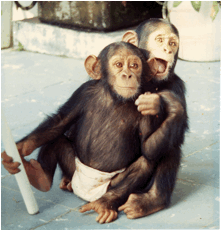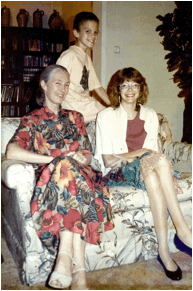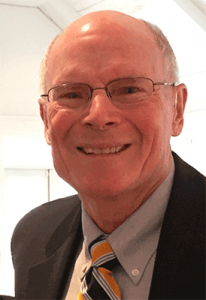by Ralph Bresler
My wife Barbara and I, and our children, were fortunate to work closely with Dr. Jane Goodall during our 1987-1991 tour in the Democratic Republic of the Congo (DRC). In 1989 Goodall called on Secretary of State James Baker in order to enlist him in her new cause of trying to save chimpanzees in the wild. After discussing her many years of groundbreaking chimpanzee research in Gombe, Tanzania, Goodall explained that, in addition to destruction of habitat, a major problem was the bushmeat trade. She noted that ten adult chimps were killed in the wild protecting every infant captured, and only one out of ten infant chimps survived the journey to the marketplace after being taken from their mothers. Secretary Baker offered the Department’s assistance to her effort. As the largest chimpanzee population was in the DRC, Kinshasa was her first stop in this new endeavor.
Our economic section took on responsibility for making arrangements for her visits. On her first trip, economic officer Chris Bane and Barbara accompanied Goodall and National Geographic photographer Mike Nichols on a tour of Kinshasa. Barbara mentioned that a chimp was for sale in the central market. Goodall insisted on checking it out and was quite upset at the sight of the chained-up infant. Ambassador Bill Harrop and others in the embassy secured the chimp’s release by working through Congolese security service contacts. The baby chimp was then cared for by Graziella Cotman, a Belgian lady, who had worked with chimps at local zoos

As counselor of embassy for economic affairs, I accompanied (and interpreted for) Goodall on several meetings with local officials when she urged the government to enact stronger legislation banning the sale of chimps, and to enforce existing laws. Sadly, the government lacked the resources and the will to have effective environmental policies. Chris Bane, Barbara and I also accompanied Goodall to meetings with local environmentalists and reporters, and at the local zoo, where chimps lived in poor conditions and exhibited many signs of stress.
Our embassy doctor, Cedric Dumont, and his wife, Ruth, took a keen interest in Goodall and her work. A second chimp was rescued; we and the Dumonts shared care of this chimp, whom we named Chris for Chris Bane. Eventually a third chimp, Calamity Jane, joined Chris. Caring for these infants was a learning experience, but very much like caring for human babies, including diapers and bottles.
Baby Chris was lethargic and barely holding on when we first brought him home. Slowly but surely he grew stronger as his health improved and a mischievous streak emerged. In the morning, he would delight in creeping under the dining table to bite the ankle of an unsuspecting daughter at breakfast and revel in the chase that ensued.
An unforeseen perk were the lazy Sunday afternoons on the veranda overlooking the Congo River with the Dumonts, sometimes other visitors, and the chimps. Calamity was truly chimplike, knuckling at top speed across the lawn, ditching her diaper in a bush at the first opportunity, and climbing trees so high we worried we would lose her. Chris seemed delayed in his development in comparison, playing only in the shorter shrubs and constantly seeking out Barbara for reassurance. But the bond between the two was immediately apparent; they clutched each other with an eagerness and a desperation that reminded us they were living in an alien world.
In spite of his caution, Chris displayed some chimpness. He would greet a new doll with a submissive back of his hand, just as wild chimpanzees do. His pant hoot conveyed the same sense of urgency, albeit for different reasons, as it would in the jungle. And he would stomp his feet and charge our daughters, typical chimp behavior.
The Bresler daughters, Jennifer and Jessica, also became activists. Jennifer started a club at the American School of Kinshasa for chimpanzee awareness and raised money for food to feed chimps at local zoos. Both girls helped with Chris’ care at home as he often needed to be held, and he loved to play with them.

After our tour ended, the Dumonts took over care of Chris and Calamity Jane. In late summer 1991 the security situation became so unsafe that most U.S. staff and all dependents were evacuated to the U.S. Dumont helped organize the first pet evacuation (Operation Noah’s Ark) from any U.S. Embassy by boat across the Congo River to Brazzaville, capital of the Republic of Congo. Ambassador Dan Phillips, his wife Lucy, and Goodall met the shipment and ensured proper treatment until the dogs and cats were sent on by air to the U.S. Dr. Dumont got permission to include several chimpanzees, including Chris and Calamity Jane, on the boat.Fortunately, CONOCO oil company financed a chimp sanctuary named Tchimpounga near Pointe Noire, Republic of Congo for the Jane Goodall Institute (JGI). One of the most important chimpanzee rescue facilities in the world, it became home for Chris and Calamity Jane.We stayed in touch with Goodall for years after our Congo experience. She was a houseguest in Arlington, and spoke at Jessica’s Yorktown High School, and Jennifer’s College of William and Mary. Jennifer has been a science teacher in Greenwich, CT since 2000. She started an award winning JGI Roots and Shoots Club, which has left a lasting impression on her students.
A foreign service career can have unexpected rewards!![]()
Addendum by Ambassador Bill Harrop

Ralph Bresler joined the Foreign Service in 1968 and served in Belgium, Chad, Ivory Coast, Kuwait and Congo over a 31-year career.
In 1992 Bresler was charge d’affaires in the newly opened embassy in Bishkek, Kyrgzstan. From 1993 to 1997 he was director of the office responsible for U.S. participation in all UN development and food and agricultural agencies. He was a senior member of our delegation to the UN Habitat conference in Istanbul. Ralph’s last position before his 1999 retirement was director of the Economic Policy Staff of the Bureau of African Affairs.
Ralph and his wife Barbara live in Oakton, Virginia.
